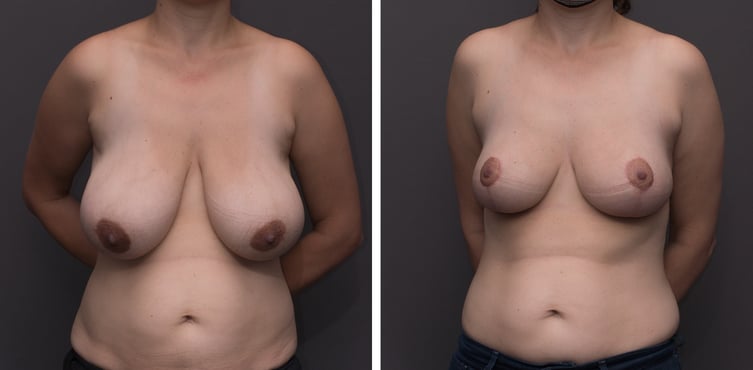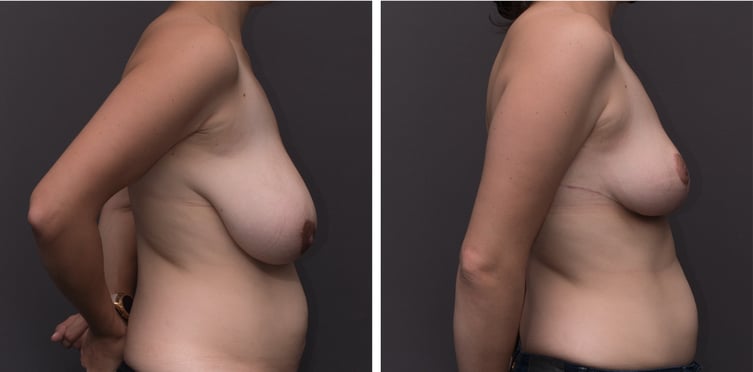Breast reduction surgery involves a combination of skin and breast tissue removal and reshaping. The surgery aims to reduce the size and weight of large breasts by lifting the breasts off the lower chest and upper abdomen. The objective is to leave the breasts smaller and lighter, sitting higher on the chest and closer to the body.
This 34-year-old came to Avery to discuss a breast reduction with Dr Avery.
Breast reduction surgery involves a combination of skin and breast tissue removal and reshaping. The surgery aims to reduce the size and weight of large breasts by lifting the breasts off the lower chest and upper abdomen. The objective is to leave the breasts smaller and lighter, sitting higher on the chest and closer to the body.
During surgery, Dr Avery was able to remove a combined weight of over 1 kg from the breasts (523g right, 513g left) and reposition the nipples higher on the breast by raising them over 10cm each. The anchor incision technique was used by Dr Avery. This is the most commonly used technique, where incisions are made extending around the areola, down the midline of the breast, and across the lower crease of the breast. There are several techniques used in breast reduction surgery depending on the existing breast tissue, the need for future breastfeeding and the desired aesthetic outcome.
Following the removal of breast tissue during breast reduction surgery, Dr Avery sends the removed tissue away for testing in a pathology lab to provide comfort to the patient that there isn’t any detection of breast cancer. This is standard protocol at Avery.
At her post surgery review, this patient commented that she had gone from wearing a 12G bra to a 12D bra – a change of over three cup sizes – and she was enjoying being more active with her young children.
Patients considering any form of surgery will need to come in for a consultation with Dr Avery to discuss your expectations, along with the surgical options for how these can be achieved. During your consultation with the Avery team, we will ensure that the surgery you are considering is the appropriate choice for you.
At Avery, we welcome the opportunity to have an open conversation with you to understand the changes you are looking for with surgery. Our patients’ stories matter a great deal to us.
Wherever you are on your personal journey, we would like to assist you. Your reasons for having surgery and your expectations from surgery are important conversations to have before undergoing surgery. Dr Avery will also assess your health and medical history to ensure any surgical procedure you are considering is a safe and appropriate choice for you.
You can also see more before and after images, here. Dr Avery has extensive experience performing surgery and as we take our patients’ privacy very seriously, we do not display our full gallery online. All patients with photographs in the gallery have provided written consent.



These photos are of a real patient who has given their consent for their photos to be shown and depict surgeries performed by Dr. Gary Avery (MED0001633092) a registered medical practitioner, with specialist registration in Surgery – Plastic Surgery .
Please note that individual results will vary depending on the individual, their genetics and lifestyle factors, and all surgeries have associated risks. Before proceeding with any surgery, it is advisable to seek a second opinion from an appropriately qualified medical practitioner such as a Plastic Surgeon.
Plastic Surgeon is a regulated term that can only be used by surgeons who have completed specialty training within plastic surgery and are Fellows of the Royal Australasian College of Surgeons (FRACS). The specialty training undertaken by Plastic Surgeons includes the surgical skills required for excellence in aesthetic surgery.